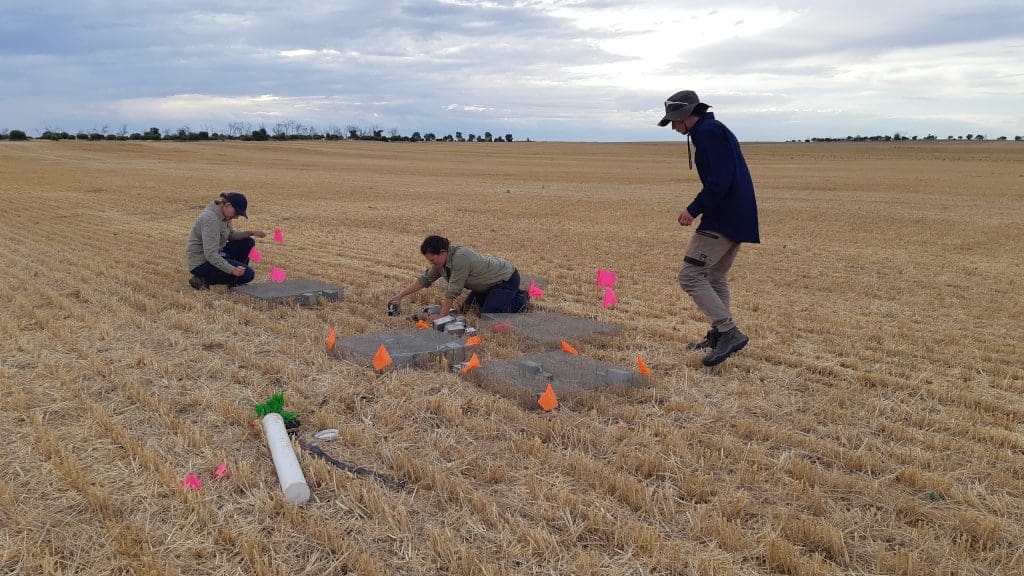
Field team target trapping around burrows to assess activity around each burrow. Photo: CSIRO Rodent Management Team
THE GRAINS Grains Research and Development Corporation and partners have announced an $11-million investment in multi-year collaborative projects to enable continued research led by Australia’s national science agency, CSIRO.
Elevated mouse populations in key grain-growing regions have led to substantial economic losses for growers over many years.
While advancements in farming systems have resulted in tremendous benefits, they have also inadvertently contributed to increasing the pest problem.
GRDC pest manager Leigh Nelson said that modern systems provide more cover from retention of crop residues, more food from increased cropping intensity, and less disturbance from reduced tillage.
“This has changed the face of mouse management on grain farms,” Dr Nelson said.
However, there are a range of management practices that can be used to reduce the impact.
“Over the years, GRDC initiatives have improved mouse surveillance techniques, refined predictive models, and promoted the widespread adoption of effective management practices through robust communication and extension activities.”
Mitigation strategy development
Senior research scientist Wendy Ruscoe is leading the research on mouse ecology to increase understanding of house mice in zero and no-till cropping systems.
Over the next five years, CSIRO research will develop a range of impact mitigation strategies by investigating:
- How different farming practices such as stubble management, strategic cultivation, and grazing can reduce food availability and habitat quality for mice, thereby lowering breeding success and survival;
- The effectiveness of baiting strategies, including how to increase toxic bait encounter rates and reduce background food competition to improve kill rates;
- Novel bait formulations e.g. coloured or pelletised bait, and how bait appearance or substrate might influence detectability and uptake by mice;
- The use of non-lethal deterrents, such as seed coatings or “chemical camouflage,” to protect freshly sown seed from mouse predation at crop establishment;
- The role of invertebrates and other high-protein food sources in supporting rapid mouse population growth, with a view to informing broader pest management strategies; and,
- The impact of non-crop habitats such as field margins and pasture paddocks as refuges or breeding grounds during low-resource periods, and their contribution to crop reinfestation.
Some of this research will be conducted in partnership with the University of Sydney, including collaborative work on novel deterrents and bait visibility based on mouse visual perception.
“The more we know about mouse behaviour in these systems, the more we can help grain growers reduce their economic impact through leading crop protection practice and mouse management techniques,” Dr Ruscoe said.
Ongoing monitoring, surveillance
Investment from GRDC will also support ongoing monitoring and surveillance of mice throughout cropping zones to predict seasonal mouse population outbreaks.
This work is being led by CSIRO research scientist Peter Brown and will include:
- Monitoring mouse activity at over 200 sites in key grain-producing areas, three times per year, to provide consistent, region-specific data;
- Enhancing spatial forecast models and developing interactive mapping tools to help growers assess mouse risk and make timely, informed management decisions;
- Field-testing and optimising remote monitoring devices that automatically detect and record mouse activity in real-time;
- Ongoing facilitation of the grower-led National Mouse Group, an information-sharing forum bringing together growers, industry and researchers; and,
- Producing and distributing seasonal “Mouse Updates” with management recommendations agreed by the National Mouse Group.
“This comprehensive portfolio of research will deliver grain growers the latest evidence-backed information on how to reduce the impact of mice in crops,” Dr Brown said.
The investments will have access to CSIRO’s recently redeveloped rodent research facility in Canberra.
The facility houses wild pest rodent species, enabling groundbreaking research into rodent management.
Source: CSIRO, GRDC

HAVE YOUR SAY